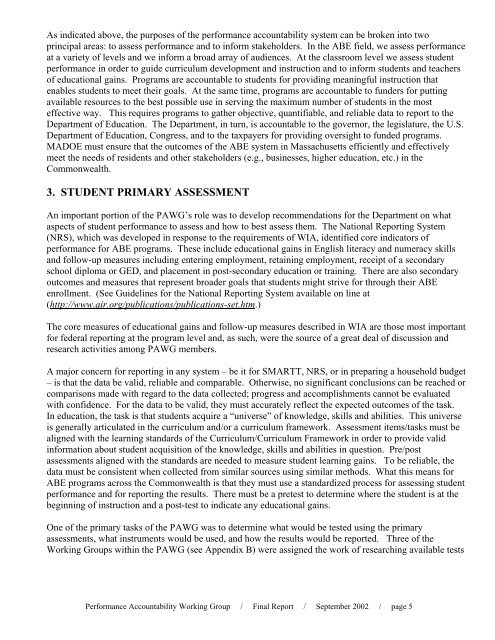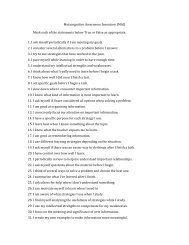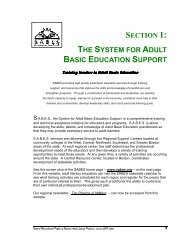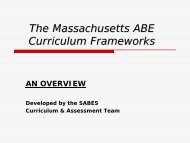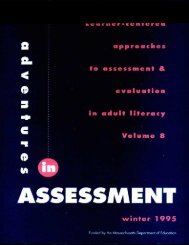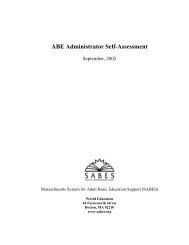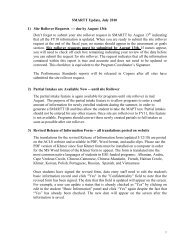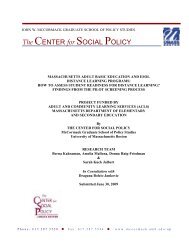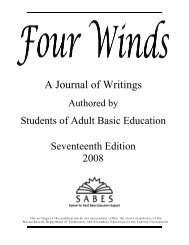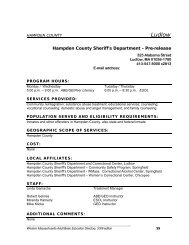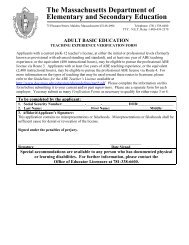PAWG I Final Report - SABES
PAWG I Final Report - SABES
PAWG I Final Report - SABES
You also want an ePaper? Increase the reach of your titles
YUMPU automatically turns print PDFs into web optimized ePapers that Google loves.
As indicated above, the purposes of the performance accountability system can be broken into two<br />
principal areas: to assess performance and to inform stakeholders. In the ABE field, we assess performance<br />
at a variety of levels and we inform a broad array of audiences. At the classroom level we assess student<br />
performance in order to guide curriculum development and instruction and to inform students and teachers<br />
of educational gains. Programs are accountable to students for providing meaningful instruction that<br />
enables students to meet their goals. At the same time, programs are accountable to funders for putting<br />
available resources to the best possible use in serving the maximum number of students in the most<br />
effective way. This requires programs to gather objective, quantifiable, and reliable data to report to the<br />
Department of Education. The Department, in turn, is accountable to the governor, the legislature, the U.S.<br />
Department of Education, Congress, and to the taxpayers for providing oversight to funded programs.<br />
MADOE must ensure that the outcomes of the ABE system in Massachusetts efficiently and effectively<br />
meet the needs of residents and other stakeholders (e.g., businesses, higher education, etc.) in the<br />
Commonwealth.<br />
3. STUDENT PRIMARY ASSESSMENT<br />
An important portion of the <strong>PAWG</strong>’s role was to develop recommendations for the Department on what<br />
aspects of student performance to assess and how to best assess them. The National <strong>Report</strong>ing System<br />
(NRS), which was developed in response to the requirements of WIA, identified core indicators of<br />
performance for ABE programs. These include educational gains in English literacy and numeracy skills<br />
and follow-up measures including entering employment, retaining employment, receipt of a secondary<br />
school diploma or GED, and placement in post-secondary education or training. There are also secondary<br />
outcomes and measures that represent broader goals that students might strive for through their ABE<br />
enrollment. (See Guidelines for the National <strong>Report</strong>ing System available on line at<br />
(http://www.air.org/publications/publications-set.htm.)<br />
The core measures of educational gains and follow-up measures described in WIA are those most important<br />
for federal reporting at the program level and, as such, were the source of a great deal of discussion and<br />
research activities among <strong>PAWG</strong> members.<br />
A major concern for reporting in any system – be it for SMARTT, NRS, or in preparing a household budget<br />
– is that the data be valid, reliable and comparable. Otherwise, no significant conclusions can be reached or<br />
comparisons made with regard to the data collected; progress and accomplishments cannot be evaluated<br />
with confidence. For the data to be valid, they must accurately reflect the expected outcomes of the task.<br />
In education, the task is that students acquire a “universe” of knowledge, skills and abilities. This universe<br />
is generally articulated in the curriculum and/or a curriculum framework. Assessment items/tasks must be<br />
aligned with the learning standards of the Curriculum/Curriculum Framework in order to provide valid<br />
information about student acquisition of the knowledge, skills and abilities in question. Pre/post<br />
assessments aligned with the standards are needed to measure student learning gains. To be reliable, the<br />
data must be consistent when collected from similar sources using similar methods. What this means for<br />
ABE programs across the Commonwealth is that they must use a standardized process for assessing student<br />
performance and for reporting the results. There must be a pretest to determine where the student is at the<br />
beginning of instruction and a post-test to indicate any educational gains.<br />
One of the primary tasks of the <strong>PAWG</strong> was to determine what would be tested using the primary<br />
assessments, what instruments would be used, and how the results would be reported. Three of the<br />
Working Groups within the <strong>PAWG</strong> (see Appendix B) were assigned the work of researching available tests<br />
Performance Accountability Working Group / <strong>Final</strong> <strong>Report</strong> / September 2002 / page 5


